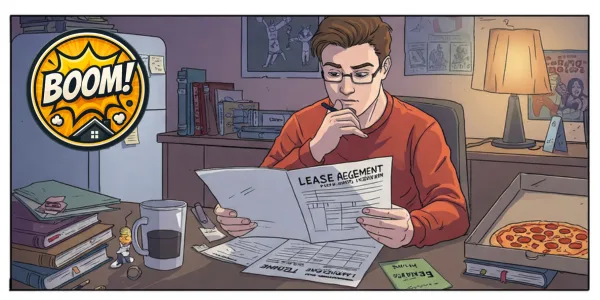How to Break Your Lease Without Penalty
Table of Contents

Introduction – How to Break Your Lease Without Penalty
When you signed your lease, you entered into a legally binding agreement—a serious commitment to your landlord, who depends on your rent to maintain their property and financial stability. Upholding that lease is a responsibility you agreed to, and breaking it can create challenges for both you and your landlord, such as lost income for them or penalties for you, which can cost $1,000–$3,000 (e.g., 1–2 months’ rent). At RepairBoom, we recognize the moral weight of this agreement on both sides. Landlords deserve reliable tenants to avoid financial strain, but we also sympathize with renters facing unexpected circumstances—like a job loss, family emergency, or sudden relocation—that may require breaking a lease as a last resort.
Breaking a lease should always be a final option, pursued only after exploring alternatives like subletting or negotiating with your landlord. Fortunately, many landlords and property management companies are willing to work with you, often helping reassign your lease to a new tenant to minimize their losses while helping you avoid penalties.
This guide offers a balanced approach to how to break your lease without penalty, providing a nationwide perspective for renters across the U.S. We’ll outline four practical steps—understanding your lease and rights, notifying your landlord respectfully, finding a replacement tenant collaboratively, and documenting the move-out process fairly—to help you exit responsibly while avoiding financial penalties. Let’s dive into the steps to break your lease legally, balancing the needs of both you and your landlord.
Before You Begin: Key Considerations for Breaking Your Lease
Breaking a lease impacts both you and your landlord, so consider both perspectives before proceeding:
- Your Responsibility as a Renter: You committed to paying rent for the lease term and breaking it can leave your landlord in a financial bind, especially if they rely on that income for mortgage payments or maintenance.
- Landlord’s Perspective: Landlords need reliable tenants to avoid the cost and hassle of re-renting, which can take weeks and cost $500–$1,500 in marketing and turnover fees. They may be more willing to cooperate if you show good faith.
- Legal Protections: Some states allow lease breaks for specific reasons (e.g., domestic violence, military deployment) without penalty, protecting renters while considering landlords’ rights.
- Penalty Risks: Both sides want a fair outcome—landlords can charge penalties (e.g., 1–2 months’ rent) if you don’t follow proper steps, but they must mitigate damages by re-renting.
- Alternatives: Explore subletting or negotiating with your landlord first, as these options can benefit both parties by avoiding financial loss.
By planning ahead, you’ll minimize risks and fulfill renter responsibilities.

Step 1: Understand Your Lease and Know Both Sides’ Rights
Spend 30–45 minutes reviewing your lease and researching the rights of both you and your landlord to approach breaking your lease responsibly. From your perspective as a renter, your lease is a binding contract, and breaking it without justification can lead to penalties of $1,000–$5,000, making it a serious decision. From the landlord’s perspective, they rely on your rent to cover expenses, and an unexpected vacancy can cause financial strain, especially for smaller landlords who may not have the resources of larger property management companies. Understanding both sides ensures you proceed fairly and increases the likelihood of cooperation.
Check your lease for early termination clauses—some allow breaking with a fee (e.g., 1–2 months’ rent), while others require landlord consent. Notice periods are typically 30–60 days, and adhering to them shows respect for your landlord’s need to plan. Nationwide, tenant rights vary by state. For example, California allows lease breaks for uninhabitable conditions (e.g., mold, Civil Code § 1941.1), while Texas permits breaks for domestic violence victims (Property Code § 92.016).
New York offers protections for seniors moving to care facilities (Real Property Law § 227-a) or for military deployment (Military Law § 309). Landlords, however, have the right to expect you to fulfill your lease or mitigate their losses by helping find a new tenant, a legal obligation for renters in many states (e.g., California Civil Code § 1951.2). Research your state’s laws via HUD (www.hud.gov) to identify protections for both parties. Document any lease violations by your landlord (e.g., failure to repair a broken heater) that might justify breaking without penalty, as these can support your case while ensuring fairness. This step helps you break your lease legally with mutual understanding.

Step 2: Notify Your Landlord Respectfully and Negotiate Fair Terms
Spend 20–30 minutes drafting and sending a formal notice to your landlord, aiming to negotiate terms that are fair for both sides and avoid penalties. From your perspective, breaking a lease is a last resort, often driven by necessity, but from the landlord’s perspective, it can disrupt their financial stability, especially if they’re a small property owner relying on your rent to cover expenses like mortgage payments. A respectful approach can encourage cooperation and reduce the risk of penalties.
Write a professional letter stating your intent to break the lease, explaining your reason (e.g., job relocation, financial hardship), and offering to help find a replacement tenant to ease their burden. Reference your state’s notice requirements (e.g., 30 days in many states) and request to avoid penalties, emphasizing your commitment to leaving the unit in good condition. For example, “I’m terminating my lease effective [date], providing 30 days’ notice as required by state law. I understand this may impact you, so I’ll assist in finding a replacement tenant to minimize your loss, and I request to avoid penalties, ensuring the unit is left in good condition.”
Send the letter via certified mail with a return receipt (~$4–$7 at USPS) to create a legal record, or email it with a read receipt if your landlord prefers digital communication. Document the submission with a timestamped photo or email screenshot. Many landlords are willing to work with you—smaller landlords may agree to waive penalties if you find a replacement tenant, while larger property management companies often have formal processes to help reassign your lease to a new tenant, benefiting both parties by avoiding legal disputes and financial loss . Negotiate terms that are fair, such as agreeing to cover marketing costs (e.g., $100–$300) in exchange for waiving larger penalties.
Ensure you’ve met your obligations, as outlined in Renter Responsibilities, to strengthen your position. This step fosters collaboration, but be prepared for some landlords to enforce penalties if they face significant losses.

Step 3: Find a Replacement Tenant to Mitigate Costs for Both Parties
Spend 1–2 hours working collaboratively to find a replacement tenant, which can help both you and your landlord avoid financial losses and penalties. From your perspective, finding a replacement tenant reduces your liability, potentially saving you $1,000–$5,000 in penalties, but from the landlord’s perspective, it ensures they don’t lose income or incur re-renting costs, which can range from $500–$1,500 for marketing and turnover. In most states, landlords are legally required to make a reasonable effort to re-rent the unit after you leave (e.g., California Civil Code § 1951.2, Texas Property Code § 91.006), but taking the initiative shows good faith and can encourage them to waive penalties.
List the apartment on platforms like Craigslist, Zillow, or local rental groups, highlighting its features (e.g., proximity to schools, amenities). Screen potential tenants by checking their references, then provide their information to your landlord for approval. Some property management companies even offer lease reassignment services, handling the process for a small fee (e.g., $200–$500), which can benefit both parties by streamlining the transition [Web ID: 7].
For example, a renter in Colorado worked with their property management company to reassign their lease, avoiding $2,400 in penalties by finding a new tenant within three weeks . Document all efforts (e.g., screenshots of listings, emails with potential tenants) to prove your cooperation, which can support your case if disputes arise. If your lease allows subletting, that’s another option—get landlord approval in writing to ensure fairness. This step minimizes financial risk for both sides, though you may still owe minor fees if the landlord incurs costs during re-renting.

Step 4: Document the Move-Out Process and Know Your Last-Resort Options
Spend 1–2 hours documenting your move-out process to ensure a fair transition for both you and your landlord, minimizing the risk of penalties or disputes, and preparing for last-resort options if your landlord refuses to let you move out or imposes penalties despite your efforts. From your perspective as a renter, thorough documentation protects you from unfair charges, potentially saving $500–$2,000 in deductions, while from the landlord’s perspective, it ensures they can accurately assess the unit’s condition and re-rent it without delay .
However, if your landlord won’t cooperate—such as refusing to accept your notice to move out or enforcing penalties despite your good-faith efforts—you’ll need to know your last-resort options to protect yourself while still considering their rights.
Start by documenting the move-out process meticulously to establish a fair record for both parties. Follow our Moving Out: Your Essential Renter Move-Out Checklist for Young Renters to clean thoroughly—landlords can charge $200–$700 for cleaning beyond normal wear (e.g., stained carpets) or $300–$800 for damages (e.g., broken fixtures), but they must justify these deductions legally . Take timestamped photos and videos showing the rental’s condition (e.g., clean floors, no damage beyond normal wear like faded paint).
Ensure you’ve met your obligations during tenancy, such as reporting maintenance issues, as outlined in Renter Responsibilities; unreported issues (e.g., a leaky faucet causing damage) can lead to charges that affect both parties—deductions for you, repair costs for the landlord. Request a final walk-through with your landlord, documenting the condition in writing or with photos to ensure transparency. Submit your forwarding address via certified mail to trigger the deposit return timeline (e.g., 21 days in California, 14 days in New York) . If charges are made, they must be reasonable—normal wear isn’t deductible, but damage you caused is, which is fair to the landlord preparing for a new tenant.
If your landlord refuses to let you move out or imposes penalties despite your efforts to mitigate damages (e.g., providing notice, finding a replacement tenant), you have last-resort options to protect your rights while remaining fair. From the landlord’s perspective, they may feel justified in enforcing the lease if they face significant financial loss, such as unpaid rent or re-renting costs ($500–$1,500) , but they’re legally required to mitigate damages by attempting to re-rent the unit in most states (e.g., California Civil Code § 1951.2).
If they’re uncooperative, start by seeking mediation through local tenant-landlord mediation programs, which are often free or low-cost and available in many cities (check HUD at www.hud.gov for resources). Mediation allows both parties to negotiate a fair resolution—perhaps agreeing to a reduced penalty in exchange for your cooperation in re-renting.
If mediation fails or your landlord still refuses to cooperate, filing a small claims lawsuit may be your final option, though it should be a last resort due to the time and cost involved (e.g., filing fees of $15–$75, 1–3 months for a hearing). In small claims court, you can argue that you took reasonable steps to mitigate damages (e.g., providing notice, finding a replacement tenant) and that the landlord’s refusal to cooperate or their penalties are unreasonable. For example, a renter in Texas successfully sued their landlord in small claims court after the landlord refused to accept a replacement tenant, winning a $2,000 penalty waiver by proving their good-faith efforts.
Present your documentation—photos, communication records, proof of replacement tenant efforts—to support your case. Be prepared for the landlord to counter with their perspective, such as claiming they couldn’t re-rent the unit due to market conditions, but courts often rule in favor of renters who show reasonable mitigation efforts . This step ensures a fair transition, protecting your finances while respecting the landlord’s right to re-rent the unit, and provides a clear path forward if cooperation breaks down.
FAQ: How to break your lease without Penalty
Can I break my lease early without penalty?

Yes, you can break your lease early without penalty if you follow legal steps, mitigate damages, and meet your responsibilities as a renter. For instance, finding a replacement tenant demonstrates good faith and can encourage your landlord to waive penalties, as it reduces their financial loss. Many landlords, especially those with larger property management companies, are willing to cooperate if you communicate openly and responsibly. Additionally, ensuring you’ve adhered to your lease terms—like paying rent on time and maintaining the unit—strengthens your position. Showing good faith through proper notice and documentation can make the process smoother for both parties
What are valid reasons to break a lease legally?

Certain states provide legal protections that allow you to break your lease without penalty under specific circumstances. For example, uninhabitable conditions like mold, severe pest infestations, or lack of heat can justify a lease break, as landlords are required to maintain livable conditions (e.g., California Civil Code § 1941.1). Domestic violence victims may also terminate leases early in states like Texas (Property Code § 92.016), while military deployment often qualifies under federal law (Servicemembers Civil Relief Act). Additionally, health issues, such as moving to a care facility in New York (Real Property Law § 227-a), can be valid reasons, ensuring renters’ rights are protected
How can I avoid lease penalties when breaking early?

To avoid lease penalties when breaking early, start by notifying your landlord respectfully with a formal letter, outlining your reasons and offering to help find a replacement tenant. Collaborating on this step shows good faith and can minimize their losses, encouraging them to waive penalties. Document the move-out process thoroughly—take photos of the unit’s condition and request a walk-through to avoid unfair charges. Following a detailed move-out plan, like the one in our Moving Out: Your Essential Renter Move-Out Checklist for Young Renters, ensures you leave the unit in good condition, reducing disputes. These steps can help you break your lease without penalty.
Can I break my lease without a penalty if I’m a victim of domestic violence?

In many regions, tenants experiencing domestic violence can break their lease without penalty under specific laws. For example, in New York, tenants can terminate their lease early by providing a 30-day notice and documentation, such as an order of protection or police report, within 25 days. Residential Tenants’ Rights Guide, New York State Attorney General. To learn how to navigate this process and protect your rights, see How to Break Your Lease Without Penalty. Always verify local laws and consult a legal professional.
What if my landlord refuses to waive penalties?

If your landlord refuses to waive penalties despite your efforts, they may enforce them due to financial losses, such as unpaid rent or re-renting costs. However, you can dispute unfair charges by first seeking mediation through local tenant-landlord programs, which offer a neutral space to negotiate a fair resolution (check HUD at www.hud.gov for options). If mediation fails, filing a small claims court lawsuit is a viable last resort, though it involves filing fees ($15–$75) and time (1–3 months). Present your documentation—photos, communication records, and proof of mitigation efforts—to support your case, as courts often favor renters who show reasonable efforts
Can I break my lease without a penalty if I’m called to active military duty?

Yes, under the federal Servicemembers Civil Relief Act (SCRA), active-duty military members can terminate a lease without penalty if they receive deployment or permanent change of station orders. You must provide written notice and a copy of your orders to the landlord, with termination effective 30 days after the next rent due date. For more details on the process, visit SCRA, U.S. Department of Justice.
Need More Rental help like this?
How to Mount a TV on the Wall in 3 Easy Steps | Free Guide
Renter Move-In Checklist | 5 Free Essential Steps
How to replace a smoke alarm battery | Free Guide – RepairBoom
How to unclog a drain in 4 easy steps | Free Guide – RepairBoom


